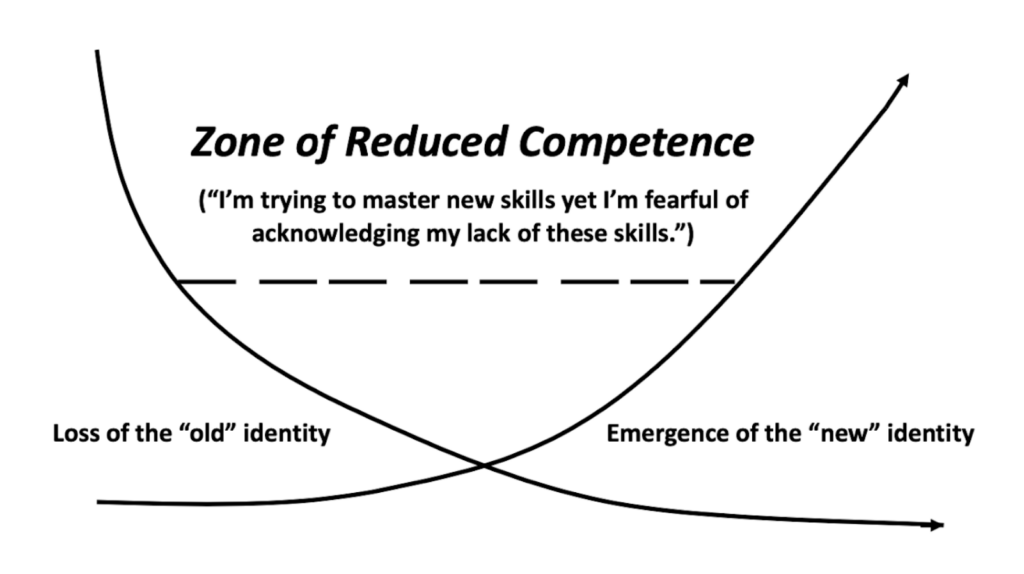The In-Between or Transition Time
Today’s Tuesday Reading is from Marcia Dority Baker, Program Leader and Leadership Coach at MOR Associates. Marcia may be reached at [email protected] or via LinkedIn.
Light precedes every transition. Whether at the end of a tunnel, through a crack in the door or the flash of an idea, it is always there, heralding a new beginning. – Theresa Tsalaky
I have been thinking about the space in between change; that transition time from the “old” to the “new.” It could be from setting a goal or practicing a new habit. Perhaps it’s using a new influence style or skill. As humans, we get pretty excited about a new thing – a shiny technology, an idea, a new service, or a self-improvement opportunity. Still, in reality, it can be hard to move through the transition from before to after.
This graphic is from the “Leadership as a Performance Art” segment of the MOR Leaders program. Some may recall the discussion of the “characters” or “roles” we play throughout our professional careers. I was initially uncomfortable with the conversation around playing a character because that seemed fake to me. A productive conversation with my coach at the time helped me put this into perspective. I told her I had “put on” my title(s) when I walked onto campus. I knew the role I had and the expectations around it. I have grown past being uncomfortable talking about leadership as a performance art. I now embrace it as an opportunity to enhance one’s leadership roles. Yes, there are multiple roles a leader needs to know, and when and where to use those roles. As each of us is unique, the way we “play” each role is authentic to who we are. For example, a risk taker for change, a politically savvy leader who understands how to navigate campus culture, or a visionary to forecast what could be the next opportunity for success on our campus. It’s exciting to think how each person brings their authentic self to the combination of roles.
Sometimes we need to move toward using new and unfamiliar skills. The time of transition (Zone of Reduced Competence) is often a space where we spend a great deal of time. This is the in-between. The movement from point A to point B or to point C. Often we approach the in-between as a by-product of change that we want to move through quickly. It can be uncomfortable to admit we don’t know a new skill yet or how to play a particular role. Growth happens in the quiet moments, in the messy space in between the old and the new. We need to pause to acknowledge and embrace the transition. This is where we mature, learn about ourselves, and see life from a different perspective.
Change is situational. Transition, on the other hand, is psychological. It is not those events, but rather the inner reorientation or self-redefinition that you have to go through in order to incorporate any of those changes into your life. Without transition, a change is just a rearrangement of the furniture. Unless transition happens, the change won’t work, because it doesn’t take. – William Bridges
I offer three approaches to embracing transition in life. For those wanting to go deeper on the topic, there are many resources available on navigating change. As a former librarian, I trust you can locate them if this is your priority. I am a believer in the power of three; three points, three steps, or three action items.
- Acceptance. People with a positive mindset approach life interested and curious about change as it is viewed as an opportunity. For some people, acceptance is also the first step to making a healthy transition. As the quote attributed to Heraclitus states, “the only constant in life is change.”
- Grace and Space. I heard this phrase a few years ago, and it stuck with me. In a nutshell, it’s the process of giving oneself the grace to step back from always solving whatever is going on and the space to learn or grow from that experience. A powerful activity practiced in our MOR programs is the reflection exercise. Invest in yourself by reflecting on what you are learning in the area of transition.
- Celebrate. Too often, we wait to celebrate accomplishments until we arrive at the deadline or the finish line. I appreciate the statement from Ralph Waldo Emerson, “life is a journey, not a destination.” As we move through the space between change, celebrating one’s accomplishments – no matter how big or small- helps keep the momentum going.
As you progress on your leadership journey, I wish you well on the space in between. Life truly is a journey, not a destination. Take care of yourself along the way.

How comfortable are you with the space in-between the “old” and the “new”?
Last week we asked about the last time you “began again” in your leadership approach, either something big or small.
- 35% said on an on-going basis, it’s a habit
- 21% said in the last month
- 14% said in the last few months
- 11% said in the last year
- 20% can’t remember the last time
This week’s reading distinguishes change as situational and transition as psychological. For most of us, change is a regular part of our work. However, as we see in the survey results, we are somewhat spread out in whether beginning again, or transitioning, is regular for us. When we are actively part of the change, that best enables our own psychological transition. However, if we find ourselves in situations where it feels like change is happening “to” us rather than “with” us, might there be an opportunity to “begin again” in exploring the psychological transition that may need to occur with the change?

- October 2025 (3)
- September 2025 (5)
- August 2025 (7)
- July 2025 (5)
- June 2025 (4)
- May 2025 (5)
- April 2025 (5)
- March 2025 (4)
- February 2025 (4)
- January 2025 (4)
- December 2024 (3)
- November 2024 (4)
- October 2024 (5)
- September 2024 (4)
- August 2024 (4)
- July 2024 (5)
- June 2024 (5)
- May 2024 (4)
- April 2024 (5)
- March 2024 (5)
- February 2024 (4)
- January 2024 (5)
- December 2023 (3)
- November 2023 (4)
- October 2023 (5)
- September 2023 (4)
- August 2023 (4)
- July 2023 (4)
- June 2023 (4)
- May 2023 (5)
- April 2023 (4)
- March 2023 (1)
- February 2023 (1)
- January 2023 (4)
- December 2022 (3)
- November 2022 (5)
- October 2022 (4)
- September 2022 (4)
- August 2022 (5)
- July 2022 (4)
- June 2022 (4)
- May 2022 (5)
- April 2022 (4)
- March 2022 (4)
- February 2022 (3)
- January 2022 (4)
- December 2021 (3)
- November 2021 (4)
- October 2021 (3)
- September 2021 (4)
- August 2021 (4)
- July 2021 (4)
- June 2021 (4)
- May 2021 (4)
- April 2021 (4)
- March 2021 (5)
- February 2021 (4)
- January 2021 (4)
- December 2020 (4)
- November 2020 (4)
- October 2020 (6)
- September 2020 (5)
- August 2020 (4)
- July 2020 (7)
- June 2020 (7)
- May 2020 (5)
- April 2020 (4)
- March 2020 (5)
- February 2020 (4)
- January 2020 (4)
- December 2019 (2)
- November 2019 (4)
- October 2019 (4)
- September 2019 (3)
- August 2019 (3)
- July 2019 (2)
- June 2019 (4)
- May 2019 (3)
- April 2019 (5)
- March 2019 (4)
- February 2019 (3)
- January 2019 (5)
- December 2018 (2)
- November 2018 (4)
- October 2018 (5)
- September 2018 (3)
- August 2018 (3)
- July 2018 (4)
- June 2018 (4)
- May 2018 (5)
- April 2018 (4)
- March 2018 (5)
- February 2018 (5)
- January 2018 (3)
- December 2017 (3)
- November 2017 (4)
- October 2017 (5)
- September 2017 (3)
- August 2017 (5)
- July 2017 (3)
- June 2017 (8)
- May 2017 (5)
- April 2017 (4)
- March 2017 (4)
- February 2017 (4)
- January 2017 (4)
- December 2016 (2)
- November 2016 (7)
- October 2016 (5)
- September 2016 (8)
- August 2016 (5)
- July 2016 (4)
- June 2016 (12)
- May 2016 (5)
- April 2016 (4)
- March 2016 (7)
- February 2016 (4)
- January 2016 (10)
- December 2015 (4)
- November 2015 (6)
- October 2015 (4)
- September 2015 (7)
- August 2015 (5)
- July 2015 (6)
- June 2015 (12)
- May 2015 (4)
- April 2015 (6)
- March 2015 (10)
- February 2015 (4)
- January 2015 (4)
- December 2014 (3)
- November 2014 (5)
- October 2014 (4)
- September 2014 (6)
- August 2014 (4)
- July 2014 (4)
- June 2014 (4)
- May 2014 (5)
- April 2014 (5)
- March 2014 (5)
- February 2014 (4)
- January 2014 (5)
- December 2013 (5)
- November 2013 (5)
- October 2013 (10)
- September 2013 (4)
- August 2013 (5)
- July 2013 (8)
- June 2013 (6)
- May 2013 (4)
- April 2013 (5)
- March 2013 (4)
- February 2013 (4)
- January 2013 (5)
- December 2012 (3)
- November 2012 (4)
- October 2012 (5)
- September 2012 (4)
- August 2012 (4)
- July 2012 (5)
- June 2012 (4)
- May 2012 (5)
- April 2012 (4)
- March 2012 (4)
- February 2012 (4)
- January 2012 (4)
- December 2011 (3)
- November 2011 (5)
- October 2011 (4)
- September 2011 (4)
- August 2011 (4)
- July 2011 (4)
- June 2011 (5)
- May 2011 (5)
- April 2011 (3)
- March 2011 (4)
- February 2011 (4)
- January 2011 (4)
- December 2010 (3)
- November 2010 (4)
- October 2010 (4)
- September 2010 (3)
- August 2010 (5)
- July 2010 (4)
- June 2010 (5)
- May 2010 (4)
- April 2010 (3)
- March 2010 (2)
- February 2010 (4)
- January 2010 (4)
- December 2009 (4)
- November 2009 (4)
- October 2009 (4)
- September 2009 (4)
- August 2009 (3)
- July 2009 (3)
- June 2009 (3)
- May 2009 (4)
- April 2009 (4)
- March 2009 (2)
- February 2009 (3)
- January 2009 (3)
- December 2008 (3)
- November 2008 (3)
- October 2008 (3)
- August 2008 (3)
- July 2008 (4)
- May 2008 (2)
- April 2008 (2)
- March 2008 (2)
- February 2008 (1)
- January 2008 (1)
- December 2007 (3)
- November 2007 (3)
- October 2007 (3)
- September 2007 (1)
- August 2007 (2)
- July 2007 (4)
- June 2007 (2)
- May 2007 (3)
- April 2007 (1)
- March 2007 (2)
- February 2007 (2)
- January 2007 (3)
- December 2006 (1)
- November 2006 (1)
- October 2006 (1)
- September 2006 (3)
- August 2006 (1)
- June 2006 (2)
- April 2006 (1)
- March 2006 (1)
- February 2006 (1)
- January 2006 (1)
- December 2005 (1)
- November 2005 (2)
- October 2005 (1)
- August 2005 (1)
- July 2005 (1)
- April 2005 (2)
- March 2005 (4)
- February 2005 (2)
- December 2004 (1)